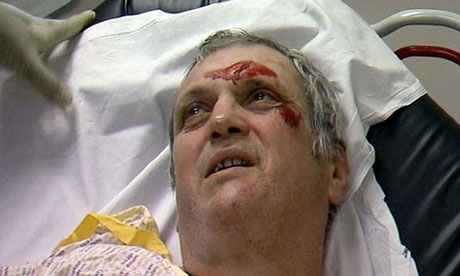
Imagine this: you are horribly injured in a car crash. You are raced to A&E, where staff spend hours piecing your broken body back together again. And then, when you eventually wake up in intensive care, you learn that the entire drama has been filmed for TV – with your life-or-death struggle as the central cliffhanger.
Of course, you are glad the ending tipped your way. But how do you feel about the filming? "I've been surprised by how unfazed patients have been," says Briony Sloper, manager of the emergency department at King's College Hospital in south-east London. "Where people were too unwell to ask for consent, we spoke to their next of kin . . . when they'd recovered, they had the right of veto over whether or not the footage was used." Most of them, says Sloper, agreed that it could. The result can be seen in Channel 4's documentary, 24 Hours in A&E, where the victims of life-threatening accidents, heart attacks and strokes jostle for space alongside more mundane cuts and fractures at one of the country's busiest emergency departments.
Why, though, did King's agree to put itself through what must have been a major upheaval? Filming the series took 28 days, using cameras that were fixed into position throughout the unit, and involved more than 3,000 staff and patients. Sloper says her incentive was "to show people what the NHS is up against", but you get the distinct impression that part of the reason for saying yes was so the unit – which had 120,000 patients last year – could put its view of why, in a cuts-driven culture, A&E departments have to be seen as a special case.
"Admissions to A&E have risen enormously over the past few years," says Sloper. "Last year saw a 10% rise, the year before that it was 7%." She cites the changes to GPs' contracts as the reason ("but don't get me started on that . . .") and says that the net result, has been further stretching of staff.
"We see lots of people with mental-health problems, we have shootings, stabbings, road traffic accidents, and we're a specialist centre for strokes, cardiac arrests and neurological conditions. But the bottom line has always been that a casualty department provides top-class care for anyone who needs it, 24 hours a day and seven days a week. It's unpredictable, it's costly, and it doesn't fit easily into a health service driven by targets and cost-cutting."
As if on cue, the bright red "emergency" phone on the wall of the trauma room, where we're talking, rings out: and within seconds, the charge nurse is preparing for a paediatric helicopter admission. He's a 10-year-old boy who has been knocked off his bike by a car. Over the next five minutes, I watch as a team of around 15 specialists – paediatric nurses, general and orthopaedic surgeons, a paediatrician and an anaesthetist among them – gather, quietly and without fuss, around the bed that has been allocated. "If they arrive alive, we're usually able to keep them that way," says Jacqui Butler, an emergency medicine consultant. "Most of the people who die have actually died before they even got here."
Suddenly the big doors open, the child is wheeled in, and the focus is palpable. Happily, within about 10 minutes, it's clear that this little boy isn't as seriously injured as was first feared. Some of the senior doctors melt away, back to their wards and their clinics. But when it might have counted, they were there.
One of the big gripes of those who manage, and work in, A&E departments, is that too many people use them inappropriately, coming in with problems more suited to their GPs – and raising awareness of this was another reason why King's agreed to the series. Among the worst offenders were a woman who was scratched by her cat, and a man who said he needed an x-ray because a tomato had fallen on his nose – a week earlier.
Others come in to complain about verrucas, splinters, cold sores and mild hay fever – then complain they have not been seen early enough. Emergency medical consultant Malcolm Tunnicliff admits: "Once or twice I've resorted to bringing a 'difficult' customer in here, to the emergency room, to show them the people who are fighting for their lives. They usually quieten down after that."
According to Lynne Watkins, head of nursing in the emergency department at King's, one of the best things about the programme from the staff point of view is that the researchers have followed up what happens next to the patients. "We rarely get to see what happens next for the people who come in," she says. "It's been so emotional for us to see their progress and find out how things turned out in the end."
But the bottom line, says Sloper, is that working in A&E makes you very grateful when your own life just trundles along normally: "What we know, because we see it every day, is that serious accidents can happen in a second. And they can change everything, for ever."

